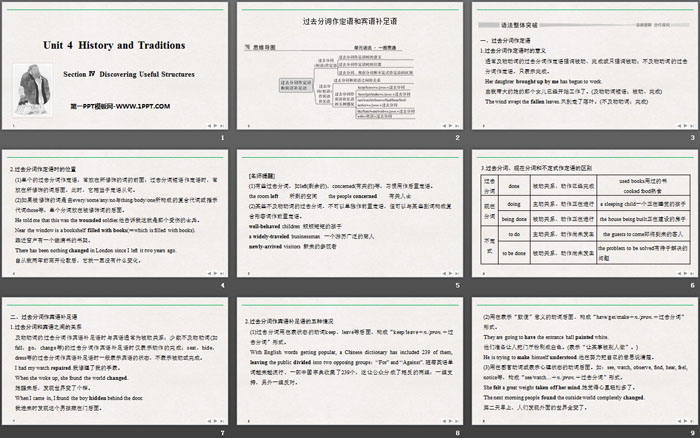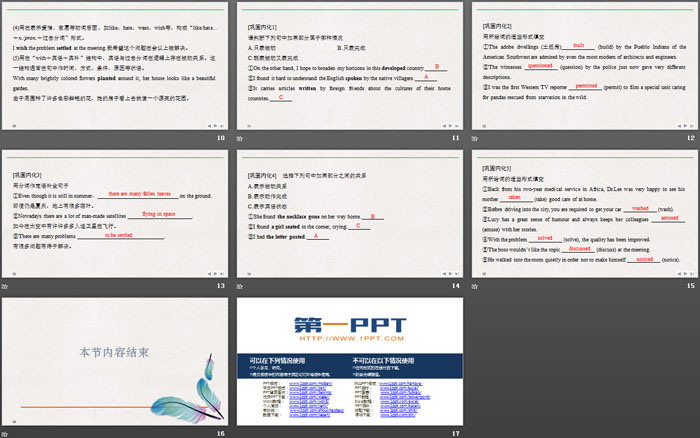Hebei Education Edition Ninth Grade English Volume 1
Hebei Education Edition Eighth Grade English Volume 2
Shanghai Education Edition Third Grade English Volume 1
Hebei Education Edition Seventh Grade English Volume 2
Foreign Language Research Edition Seventh Grade English Volume 1
Hebei Education Edition Eighth Grade English Volume 1
Hebei Education Edition Fourth Grade English Volume 1
Oxford Translation English for Grade 9 Volume 1
Foreign Language Research Edition Fourth Grade English Volume 1
People's Education Press Eighth Grade English Volume 1
Hebei Education Edition 8th Grade English Volume 1
Hebei Education Edition Sixth Grade English Volume 1
High School English Compulsory Course 1, Foreign Language Research Edition
Guangzhou Edition Sixth Grade English Volume 1
Oxford Translation English for Grade 5 Volume 2
Oxford Translation English for Grade 6 Volume 2

| Category | Format | Size |
|---|---|---|
| People's Education Press High School English Compulsory Course 2 | pptx | 6 MB |
Description
"History and Traditions" SectionⅣ PPT courseware
Past participle as attributive and object complement
Overall breakthrough in grammar
1. Past participle as attributive
1. The meaning of the past participle as an attributive
Usually the past participle of a transitive verb is used as an attributive to emphasize the passive, perfect or only passive; the past participle of an intransitive verb is used as an attributive and only expresses completion.
Her daughter brought up by me has begun to work.
Her daughter, whom I raised, has started working. (transitive verb phrase; passive, perfect)
The wind swept the fallen leaves. The wind swept away the fallen leaves. (intransitive verb; perfect)
2. The position of the past participle as an attributive
(1) When a single past participle is used as an attributive, it is often placed in front of the word it modifies; when a past participle phrase is used as an attributive, it is often placed after the word it is modified. At this time, it is equivalent to an attributive clause.
(2) If the modified word is a compound pronoun or demonstrative pronoun those composed of every/some/any/no and thing/body/one, the single participle is placed after the modified word.
He told me that this was the wounded soldier. He told me that this was the wounded soldier.
Near the window is a bookshelf filled with books (=which is filled with books).
There is a bookshelf full of books near the window.
There has been nothing changed in London since I left it two years ago.
London hasn't changed much since I left it two years ago.
[Famous Teacher Reminder]
(1) Some past participles, such as left (remaining), concerned (related), etc., are used to be used as postpositional attributives.
the room leftthe people concerned
(2) The past participle of some intransitive verbs cannot be used as a prepositional attributive alone, but it can be combined with some adverbs to form a compound adjective as a prepositional attributive.
well-behaved children well-behaved children
a widely-traveled businessman a widely traveled businessman
newly-arrived visitors newly arrived visitors
2. Past participle as object complement
1. The relationship between past participle and object
When the past participle of a transitive verb is used as an object complement, it usually has a passive relationship with the object; when the past participle of a few intransitive verbs (such as fall, go, change, etc.) is used as an object complement, it only expresses the completion of the action; seat, hide, When the past participle of dress, etc. is used as an object complement, it generally indicates the state of the object and does not indicate passivity or completion.
I had my watch repaired. I had my watch repaired.
When she woke up, she found the world changed.
When she woke up, she found that the world had changed.
When I came in, I found the boy hidden behind the door.
When I came in I found this boy hiding behind the door.
2. Five situations in which the past participle is used as an object complement
(1) The past participle is used after the state verbs keep, leave, etc. to form the form of "keep/leave+n./pron.+past participle".
With English words getting popular, a Chinese dictionary has included 239 of them, leaving the public divided into two opposing groups: “For” and “Against”. This divided the public into two opposing groups: those who supported it and those who opposed it.
(2) Used after a verb expressing the meaning of "causing" to form the form of "have/get/make+n./pron.+past participle".
They are going to have the entrance hall painted white.
They were going to have the foyer painted white. (Meaning "to cause something to be done by someone else.")
He is trying to make himself understood. He is trying to make himself understood.
(3) Used after sensory verbs or verbs expressing mental states. For example: see, watch, observe, find, hear, feel, notice, etc., forming the form of "see/watch...+n./pron.+past participle".
She felt a great weight taken off her mind. She felt much lighter.
The next morning people found the outside world completely changed.
The next morning, people found that the outside world had completely changed.
Keywords: Free download of High School English Compulsory Course 2 PPT courseware from the People's Education Press, History and Traditions PPT download, .PPT format;
For more information about the "history_and_traditions" PPT courseware, please click the history_and_traditionsPPT tag.
"History and Traditions" SectionⅧ PPT courseware:
"History and Traditions" Section Ⅷ PPT courseware Ⅰ. Fill in the blanks with single sentence grammar 1. Modern science has given clear evidence that smoking can lead ____________ many diseases. 2. The physics prob..
"History and Traditions" SectionⅦ PPT courseware:
"History and Traditions" Section Ⅶ PPT courseware Part One: Explanatory text introducing the place. The reading and writing task of this unit is to first read an article about Ireland and then write an explanatory text introducing the place. Ⅰ.Pre-writing (Ⅰ)Lea..
"History and Traditions" SectionⅥ PPT courseware:
"History and Traditions" Section Ⅵ PPT courseware Part 1: Basic passing of the class Ⅰ. Word context memory Write the appropriate form of the word according to the English and Chinese prompts 1. He finally found a hotel at the corner of the stree..
File Info
Update Time: 2024-09-09
This template belongs to English courseware People's Education Press High School English Compulsory Course 2 industry PPT template
"History and Traditions" SectionⅣ PPT courseware Simple campus recruitment activity planning plan summary enterprise and institution recruitment publicity lecture PPT template is a general PPT template for business post competition provided by the manuscript PPT, simple campus recruitment activity planning plan summary enterprise and institution recruitment promotion Lecture PPT template, you can edit and modify the text and pictures in the source file by downloading the source file. If you want more exquisite business PPT templates, you can come to grid resource. Doug resource PPT, massive PPT template slide material download, we only make high-quality PPT templates!
Tips: If you open the template and feel that it is not suitable for all your needs, you can search for related content "History and Traditions" SectionⅣ PPT courseware is enough.
How to use the Windows system template
Directly decompress the file and use it with office or wps
How to use the Mac system template
Directly decompress the file and use it Office or wps can be used
Related reading
For more detailed PPT-related tutorials and font tutorials, you can view: Click to see
How to create a high-quality technological sense PPT? 4 ways to share the bottom of the box
Notice
Do not download in WeChat, Zhihu, QQ, built-in browsers, please use mobile browsers to download! If you are a mobile phone user, please download it on your computer!
1. The manuscript PPT is only for study and reference, please delete it 24 hours after downloading.
2. If the resource involves your legitimate rights and interests, delete it immediately.
3. Contact information: service@daogebangong.com
"History and Traditions" SectionⅣ PPT courseware, due to usage restrictions, it is only for personal study and reference use. For commercial use, please go to the relevant official website for authorization.
(Personal non-commercial use refers to the use of this font to complete the display of personal works, including but not limited to the design of personal papers, resumes, etc.)
Preview












